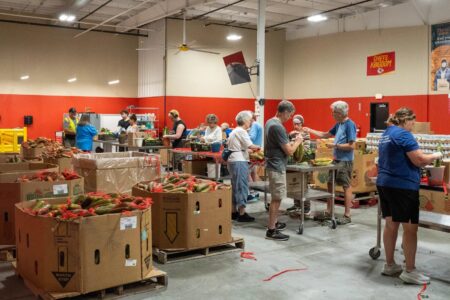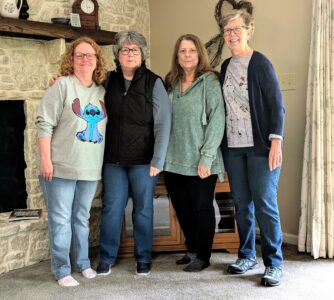Worry was everywhere at local food banks last week, but so too was some ‘beautiful’ community support
Multiple food drives stocked shelves, and one effort raised $77K for Just Food

photo by: Zane Irwin, Kansas News Service
At the Harvesters food bank distribution center in Lawrence, Kansas, volunteers pack produce destined for a local food pantry.
For individuals and families relying on the safety net of federal and local food programs, the last week to 10 days have been dizzying and stressful.
Thankfully, there have been a few other emotions too.
“The uncertainty has been uneasy for so many,” Elizabeth Keever, the chief resource officer for Harvesters Community Food Network, said. “But there have been some beautiful moments of people stepping up.”
The uncertainty has come from the federal government shutdown, but has been heightened by federal court rulings that ordered the Trump administration to fully fund the Supplemental Nutrition Assistance Program for November. But then a Friday evening order from the Supreme Court — sparked by an appeal from the Trump administration — temporarily put on hold the order that the SNAP funds be distributed.
Kansas residents who rely on SNAP already had their November food assistance payments downloaded onto their electronic debit cards when the Supreme Court order came down Friday night. Kansas Gov. Laura Kelly on Friday afternoon had ordered the state’s food assistance agency to quickly disburse the funds, eschewing the normal process of distributing them in phases.
What happens to December payments and beyond, however, is still murky. As of Monday afternoon, there were fresh signs that the U.S. House and U.S. Senate were nearing a compromise that would end the federal shutdown, and presumably would resume SNAP payments in a more ordinary way.
However, the search for normal may be elusive in the world of food assistance for quite some time. Previous budget actions approved before the shutdown — namely the Trump administration’s Big Beautiful Bill — make significant changes to SNAP and who may be eligible for the assistance.
At this point, professionals who work at distributing food to those in need are still grasping how much the system has been shaken.
“We were in uncharted waters,” Keever said last week. “Since the creation of the SNAP program six decades ago we had never seen a lapse of payment. It has been an absolute whirlwind.”
•••
Harvesters — which operates a warehouse in Lawrence — serves 27 counties across northeast Kansas and northwest Missouri, distributing food to a network of more than 900 partner agencies.
Keever said when the federal shutdown started last month, the network moved its resources to assist the nearly 40,000 federal workers in the region — focusing mainly on Jackson County, Missouri, and its surrounding areas. When the organization learned there were issues with SNAP payments for people across all its counties, Keever said the calculus changed fast.
“We knew we needed to shift gears and open up additional products across the entire network that we served,” Keever said.
In the space of a week, Keever said Harvesters was able to release around $500,000 of food to its partner agencies. She said many of those partners told Harvesters they were seeing “a lot of new people” or people they “hadn’t seen in a long time.”
That spike in demand was something that Kyle Roggenkamp, the CEO of the Ballard Center in Lawrence, saw last week. The center opened its expanded food pantry at the beginning of last week, which allowed for a doubling of available appointment times, but Roggenkamp said the organization struggled to keep up with the demand from the people it served.
“The need for food was so high,” Roggenkamp said.
Roggenkamp also was worried about the “domino effects” that impact people who are facing food insecurity. He said the center’s rent and utility assistance program in October was used at a rate that they had never seen. He said he was concerned that people were forced to make choices between feeding themselves or potentially paying rent or utilities.
Keever said she heard similar situations from other partners on the ground. She said one worker was on the phone with a person who had to choose between staying in line waiting at a mobile food pantry or being late for their shift at work.
“We definitely saw a lot of anxiety,” Keever said. “(There were) real-life hard choices that people were making.”
•••
Even before the potential loss of SNAP benefits, local food organizations were working to try to support their neighbors.
On Oct. 31, the Lawrence Farmers Market announced it would continue to fund a local food assistance program that helps SNAP users buy proteins. And Just Food announced the same day the creation of a fund called the “Douglas County Partner Pantry Fund” through the Douglas County Community Foundation to ensure children, families and neighbors continue to have access to food.
Chip Blaser, the executive director of the Douglas County Community Foundation, told the Journal-World that the foundation forwarded $77,995 in donations and other grants to Just Food as part of the pantry response fund. Those funds came from 160 donors and various fund holders.
Roggenkamp said during the week, the community “beautifully stepped up” to support the efforts. Volunteers came by “left and right” to help the center and donations came to the pantry from food drives that the center “didn’t even know were happening.” Roggenkamp said that all kinds of people — from 8-year-olds to 95-year-olds in a retirement community — helped gather food to distribute to their neighbors in need.
“People are craving an opportunity to make an impact,” Roggenkamp said. “It was beautiful to see how people reacted.”
Keever said similar stories popped up across the wide region that Harvesters serves. Although there was much confusion and concern, she said there were also “beautiful” moments of community members or local businesses supporting people.
“It shines a light on the support and humanity that is in the community,” Keever said.
•••
Although the community support during the week was crucial, nonprofit leaders don’t want to lose sight of the potential lasting effects and the rise in food insecurity.
Keever said Harvesters has seen about a 10% increase in demand across its network in the past year. In Douglas County, Keever said there are 16,680 individuals experiencing food insecurity — which is about 1 in every 7 — and 1 in 6 children in the county are considered food insecure.
While food banks and pantries are crucial components in fighting food insecurity, they don’t have the resources to be the lone safety net for people. Keever said Harvesters receives about $18 million in charitable support annually. The total money that SNAP provided to Harvesters’ 27-county area in one month is about $34 million — an “insurmountable gap” to support hungry people, according to Keever.
A potential silver lining from the past week was that the crisis may have “opened people’s eyes” to how crucial SNAP is to the country. Keever said she felt people were discussing the program’s importance in a way she has never heard before, with people recognizing how it is the country’s “most efficient way of fighting hunger.”
“Food banks and partner organizations are the supplement to our Supplemental Nutrition Assistance Program,” Keever said. “It does far more than we can ever do to serve our neighbors.”
But food banks and pantries will likely be tested further this year. Keever said that the “Big Beautiful Bill” passed by Congress earlier this year saw “significant cuts” to the SNAP program, and organizations are starting to see the effects of people falling off the program.
Roggenkamp said he is still worried about the ongoing domino effect from the shock of the past week.
“There will still be impacts from this,” Roggenkamp said, expressing concerns that those might only be seen three to six months later.
While the community support was really crucial during the last week, Roggenkamp is hopeful that people keep showing support beyond this crisis period because it’s “the only way we’ll get through” the harmful effects caused by the funding lapse. Roggenkamp encourages people to continue to donate food, money or time to nonprofits or pantries they have the closest relationship to.
Keever also urged people to keep providing support through whichever organization calls to them the most because “there is no wrong way to give back.” She said for Harvesters specifically, that monetary donations go the furthest. Keever said every dollar the food bank receives equates to providing two meals, and it allows Harvesters to buy exactly what it and its partners need to buy right at that moment. For example, most of the year, users do not want cranberry sauce, but the demand for it surges around Thanksgiving. In addition, the food bank pays wholesale prices and no sales tax, so it can get “more bang for the buck for every dollar,” Keever said.
Although nonprofits across Douglas County will still face additional challenges during the busy holiday time of the year, community support helped them get through an incredibly uncertain time. Keever said the experiences of this past week show that the system needs every link of the chain, from government benefits to community support, to fight against hunger.
“The charitable food system needs every layer to do this work,” Keever said.






